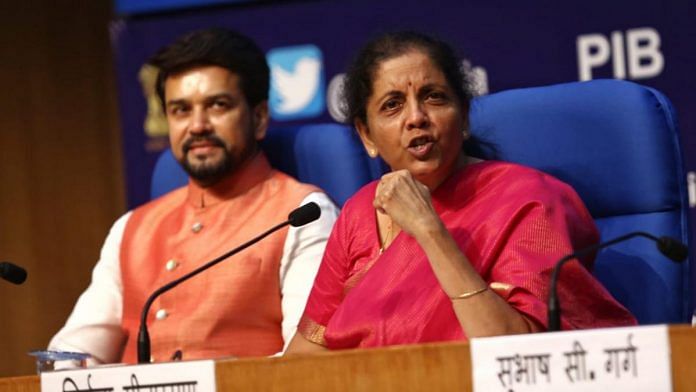New Delhi: The Narendra Modi government has come in for criticism for using the revised tax collection numbers for 2018-19 in the Union Budget presented on 5 July instead of actual numbers, with some opposition members accusing the government of fudging data as Rs 1.7 lakh crore didn’t seem accounted for.
But turns out the government was just following the traditional budgeting practice.
All the election year budgets presented in July-August have used revised estimates for the previous year rather than the actual numbers.
Speaking to ThePrint, Subhash Chandra Garg, Secretary, Economic Affairs, said the government has stuck to the budgeting practice that has been followed in the previous years.
To be sure, this does not affect the fiscal math of the government.
Despite the huge shortfall in tax collections of nearly Rs 1.7 lakh crore, the government managed to meet its fiscal deficit target of 3.4% of gross domestic product in 2018-19 as it contracted expenditure in the last two months of the financial year. The actual expenditure of the government was lower by Rs 1.45 lakh crore than what was accounted for in the revised estimates.
Also read: Budget 2019 will boost growth only if Modi govt is friendly towards business and profits
What to make of ‘missing’ Rs 1.7 lakh crore
The Modi government used the revised estimates for 2018-19 in its budget for 2019-20 rather than the provisional actual numbers. The move came even as the Economic Survey provided the provisional estimates of net tax collections at Rs 13.16 lakh crore as against the revised tax revenue projections of Rs 14.84 lakh crore.
But the main reason underlying the criticism is the stark variation in the revised and the actual numbers.
The variation between the revised estimates and the actual tax collections was more than Rs 1.67 lakh crore, the highest ever.
The shortfall reported in 2018-19 is more than double the shortfall reported in all the previous ten years put together.
The total shortfall reported in the period between 2008-09 and 2017-18 was Rs 80,908 crore with the highest gap reported at Rs 26,966 crore in 2017-18.
Analysts and government officials attribute the huge tax collection shortfall to the aggressive revised targets set in the interim budget presented in February this year by then finance minister Piyush Goyal, the over-estimation of the nominal GDP as well as to the massive growth slowdown witnessed in the last quarter of 2018-19.
Despite lagging tax revenues, Goyal revised the direct tax collection targets upwards by Rs 50,000 crore for 2018-19. In addition, the scaling down of the GST tax collections was also far less than what was warranted by the trend in GST collections.
Also read: Base year, revised growth, overestimation & all that you need to know about calculating GDP
‘Not a logical argument’
Typically, the budget numbers presented at the beginning of the year are revised based on the actual collection trends and growth rates at the time of the presentation of the next year’s budget in February.
The actual tax numbers are available after 31 March while the revised estimates are presented on 1 February. Until 2017, the revised budget numbers were presented on 28 February giving the government an extra month to get an accurate picture of the tax collections.
N.R. Bhanumurthy, professor at National Institute of Public Finance and Policy, said there was no need to continue with the practice of stating revised numbers in the July budget when the actual picture is available.
“With the introduction of GST, by April, you have some clarity on the indirect taxes front. There is an increase in the speed of information flow in the fiscal statistics.
“It is not a logical argument to continue with past practices. The fiscal position has completely changed in the last five years,” he said.
Bhanumurthy was also critical of the Modi government’s decision to move ahead the budget to 1 February pointing out that this has led to many aberrations.
“Because of the advancement, errors happen in the revised revenue projections. Further, GDP growth projections are also made early for the next year and consequently the revenue projections for the next year are also error prone,” he said.
Projecting the GDP growth as close as possible is crucial to get accurate revenue forecasts, said Bhanumurthy.
Rating agency Fitch said in a note Tuesday that the “the fiscal targets are broadly credible, although projected revenue growth, at 13.5%, may prove optimistic as it is based on the government’s higher 7.0% real GDP growth forecast and disinvestment targets might not be met.”
The agency added that there is also a recent history of slippage relative to targets.
Also read: Modi govt’s big water push in Budget 2019: Rs 8245 crore for Jal Shakti ministry




Whether coincidence or otherwise, when all these mixups show things to be better than they are, one begins to wonder. By the law of averages, it should be fifty – fifty.